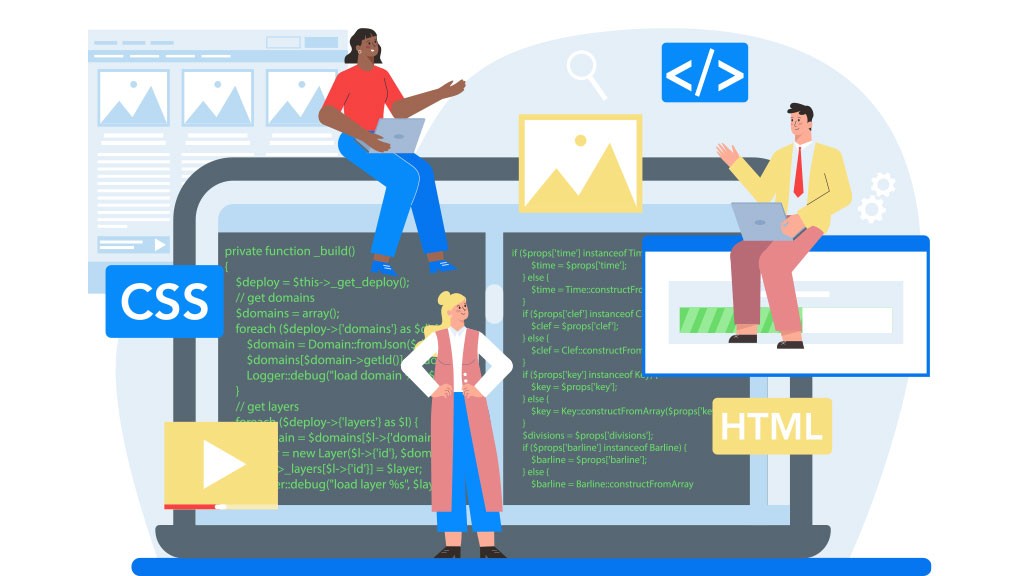Blogs
Connecting ideas and people – how talk can change our lives.

OpenAI vs. DeepSeek A Comprehensive Comparison of Two AI Powerhouses
Artificial Intelligence (AI) is transforming industries, enhancing productivity, and reshaping technological interactions. Among the key players in AI, OpenAI and DeepSeek stand out, each contributing uniquely to the field. While OpenAI is a leader in AI research and artificial general intelligence (AGI) development, DeepSeek is gaining traction with its industry-specific AI solutions.
In this in-depth comparison, we analyze their origins, technologies, applications, and market impact, helping businesses make informed decisions when leveraging AI.
Origins and Background
OpenAI: Advancing AI for Humanity
Founded in 2015, OpenAI's mission is to develop AI that benefits humanity. It has pioneered GPT-4, DALL•E, Codex, and CLIP, leading advancements in natural language processing (NLP), image generation, and AI-powered automation.
DeepSeek: The Emerging AI Innovator
DeepSeek is a rising AI company focusing on practical AI applications. Unlike OpenAI, which pursues AGI, DeepSeek specializes in AI-powered analytics, automation, and personalized recommendations for industries like healthcare, finance, and e-commerce.
Core Technologies and Innovations
OpenAI’s AI Models
- GPT-4 – Leading NLP model for text generation and conversational AI
- DALL•E – AI-powered image generation from text prompts
- Codex – AI-driven coding assistant (GitHub Copilot)
- CLIP – Advanced AI for image-text recognition
DeepSeek’s AI Solutions
- AI-Powered Analytics – Data-driven insights for business intelligence
- Recommendation Systems – AI-driven personalized content suggestions
- Automation Platforms – AI-powered tools optimizing workflows and efficiency
Applications and Use Cases
OpenAI’s AI in Various Industries
Healthcare – AI for medical diagnoses & patient care reports
Education – AI-powered tutoring systems & content generation
Entertainment – AI-generated visuals, scripts, & creative content
Software Development – AI-driven coding assistants & automation
DeepSeek’s Industry-Specific AI Applications
E-commerce – AI-enhanced product recommendations
Finance – AI for fraud detection & investment analysis
Healthcare – AI-powered diagnostics & predictive analytics
Customer Service – AI chatbots & automation for improved support
Ethical Considerations and Challenges
OpenAI’s Responsible AI Approach
- Emphasizes transparency, fairness, and accountability
- Restricts advanced model access to prevent misuse
- Advocates ethical AI development and policy collaboration
DeepSeek’s Ethical AI Commitment
- Minimizes AI bias through curated datasets
- Prioritizes data security and compliance
- Delivers AI solutions tailored for specific industry needs
Future Prospects and Industry Impact
OpenAI’s Vision for AGI
- OpenAI’s goal is Artificial General Intelligence (AGI)
- Future developments will focus on scalability, deep learning, and ethical AI
DeepSeek’s Growth Strategy
- DeepSeek aims to expand its AI solutions for businesses
Emphasizes user-friendly AI adoption and practical industry applications
Key Differences Between OpenAI and DeepSeek
|
Aspect |
OpenAI |
DeepSeek |
|
Focus |
AGI development, AI research |
Niche AI solutions for businesses |
|
|
|
|
|
Technologies |
GPT-4, DALL•E, Codex, CLIP |
AI analytics, recommendation engines, automation |
|
Applications |
Healthcare, education, entertainment, software development |
E-commerce, finance, healthcare, customer service |
|
Ethical Approach |
Transparency, fairness, inclusivity |
Bias minimization, privacy, compliance |
|
Market Presence |
Global AI leader |
Emerging AI innovator |
Conclusion: OpenAI and DeepSeek – Complementary AI Forces
OpenAI and DeepSeek take distinct but complementary approaches to AI innovation. OpenAI focuses on broad AI research and AGI, while DeepSeek delivers practical, industry-specific AI solutions.
As AI continues to revolutionize businesses, understanding these two AI powerhouses is crucial for making strategic AI investments. Whether you need AI for automation, data analytics, customer engagement, or process optimization, both OpenAI and DeepSeek offer transformative opportunities.
Stay ahead in AI innovations with Montek Services – Your Trusted AI & Tech Partner!
Final Thoughts
The AI landscape is evolving rapidly, and the competition between OpenAI and DeepSeek highlights the diversity in AI development. Follow Montek Services for more AI insights, trends, and practical AI solutions tailored for businesses.
Why Optimize AI Solutions with Montek Services?
- AI-powered business transformation
- Custom AI solutions for industries
- Data-driven strategies for growth
- Expert insights into AI trends
Need AI solutions? Contact Montek Services today!

Date: 07, January 2025
The Top 5 Reasons Why Contingency Based Headhunting is Still the Best Way to Recruit Exceptional Talent
In the dynamic and competitive world of recruitment, finding and securing exceptional talent is a top priority for businesses across industries. Among the various methods employed to identify and hire top candidates, contingency-based headhunting has stood the test of time. This approach, where recruiters only get paid upon the successful placement of a candidate, offers distinct advantages that make it a preferred choice for many organizations. Here are the top five reasons why contingency-based headhunting remains the best way to recruit exceptional talent.
1. Cost-Effective Recruitment
1.1. Pay for Results
One of the most significant advantages of contingency-based headhunting is its cost-effectiveness. In this model, companies only pay the recruiter when a successful placement is made. This results-oriented payment structure ensures that businesses do not incur costs unless they see tangible results.
1.2. No Upfront Fees
Unlike retained search models that require upfront fees regardless of the outcome, contingency-based recruitment eliminates the risk of paying for a service without guaranteed results. This is particularly beneficial for small and medium-sized enterprises (SMEs) that may have limited recruitment budgets.
2. Access to a Broader Talent Pool
2.1. Extensive Networks
Contingency recruiters typically work with multiple clients and have extensive networks within various industries. This broad reach allows them to tap into a larger pool of candidates, including those who might not be actively seeking new opportunities but are open to the right offer.
2.2. Diverse Candidate Profiles
The wide-ranging connections of contingency recruiters mean they can present candidates with diverse backgrounds and skill sets, increasing the chances of finding the perfect fit for a specific role. This diversity in candidate profiles is crucial for organizations looking to foster innovation and creativity within their teams.
3. Faster Time-to-Hire
3.1. Incentivized Efficiency
The contingency model inherently incentivizes recruiters to work quickly and efficiently. Since payment is contingent on a successful placement, recruiters are motivated to expedite the hiring process and present qualified candidates as soon as possible.
3.2. Streamlined Processes
Experienced contingency recruiters have honed their processes to quickly identify and screen top talent. Their expertise in matching candidates to job requirements means they can often shorten the time-to-hire compared to internal HR teams or other recruitment methods.
4. Quality Over Quantity
4.1. Focus on Fit
Contingency recruiters prioritize the quality of candidates over the quantity of applications. Their goal is to find the best possible match for the role, considering both technical skills and cultural fit within the organization. This focus on quality leads to higher retention rates and greater overall satisfaction for both the employer and the employee.
4.2. Thorough Screening
To ensure a successful placement, contingency recruiters conduct thorough screenings and assessments of candidates. This includes evaluating resumes, conducting interviews, and checking references. The rigorous vetting process ensures that only the most qualified candidates are presented to the hiring company.
5. Flexibility and Scalability
5.1. Adaptability to Business Needs
Contingency-based headhunting offers flexibility that can adapt to the changing needs of a business. Whether a company is looking to fill a single critical position or scale up its workforce quickly, contingency recruiters can adjust their efforts accordingly without long-term commitments.
5.2. Scalable Solutions
For organizations experiencing rapid growth or seasonal hiring spikes, contingency recruiters provide scalable solutions that can handle varying levels of recruitment demand. This scalability ensures that companies can maintain their hiring momentum without overwhelming their internal HR resources.
Conclusion
In the ever-evolving landscape of recruitment, contingency-based headhunting remains a highly effective and efficient method for sourcing exceptional talent. Its cost-effectiveness, access to a broad talent pool, faster time-to-hire, focus on quality, and flexibility make it an ideal choice for businesses looking to build strong, capable teams.
By partnering with experienced contingency recruiters, organizations can enhance their recruitment strategies and secure top talent that drives long-term success and growth

Date: 07, January 2025
Top 5 Reasons Why Contingency Headhunting Excels in Talent Recruitment
In the dynamic and competitive world of recruitment, finding and securing exceptional talent is a top priority for businesses across industries. Among the various methods employed to identify and hire top candidates, contingency-based headhunting has stood the test of time. This approach, where recruiters only get paid upon the successful placement of a candidate, offers distinct advantages that make it a preferred choice for many organizations. Here are the top five reasons why contingency-based headhunting remains the best way to recruit exceptional talent.
1. Cost-Effective Recruitment
1.1. Pay for Results
One of the most significant advantages of contingency-based headhunting is its cost-effectiveness. In this model, companies only pay the recruiter when a successful placement is made. This results-oriented payment structure ensures that businesses do not incur costs unless they see tangible results.
1.2. No Upfront Fees
Unlike retained search models that require upfront fees regardless of the outcome, contingency-based recruitment eliminates the risk of paying for a service without guaranteed results. This is particularly beneficial for small and medium-sized enterprises (SMEs) that may have limited recruitment budgets.
2. Access to a Broader Talent Pool
2.1. Extensive Networks
Contingency recruiters typically work with multiple clients and have extensive networks within various industries. This broad reach allows them to tap into a larger pool of candidates, including those who might not be actively seeking new opportunities but are open to the right offer.
2.2. Diverse Candidate Profiles
The wide-ranging connections of contingency recruiters mean they can present candidates with diverse backgrounds and skill sets, increasing the chances of finding the perfect fit for a specific role. This diversity in candidate profiles is crucial for organizations looking to foster innovation and creativity within their teams.
3. Faster Time-to-Hire
3.1. Incentivized Efficiency
The contingency model inherently incentivizes recruiters to work quickly and efficiently. Since payment is contingent on a successful placement, recruiters are motivated to expedite the hiring process and present qualified candidates as soon as possible.
3.2. Streamlined Processes
Experienced contingency recruiters have honed their processes to quickly identify and screen top talent. Their expertise in matching candidates to job requirements means they can often shorten the time-to-hire compared to internal HR teams or other recruitment methods.
4. Quality Over Quantity
4.1. Focus on Fit
Contingency recruiters prioritize the quality of candidates over the quantity of applications. Their goal is to find the best possible match for the role, considering both technical skills and cultural fit within the organization. This focus on quality leads to higher retention rates and greater overall satisfaction for both the employer and the employee.
4.2. Thorough Screening
To ensure a successful placement, contingency recruiters conduct thorough screenings and assessments of candidates. This includes evaluating resumes, conducting interviews, and checking references. The rigorous vetting process ensures that only the most qualified candidates are presented to the hiring company.
5. Flexibility and Scalability
5.1. Adaptability to Business Needs
Contingency-based headhunting offers flexibility that can adapt to the changing needs of a business. Whether a company is looking to fill a single critical position or scale up its workforce quickly, contingency recruiters can adjust their efforts accordingly without long-term commitments.
5.2. Scalable Solutions
For organizations experiencing rapid growth or seasonal hiring spikes, contingency recruiters provide scalable solutions that can handle varying levels of recruitment demand. This scalability ensures that companies can maintain their hiring momentum without overwhelming their internal HR resources.ConclusionIn the ever-evolving landscape of recruitment, contingency-based headhunting remains a highly effective and efficient method for sourcing exceptional talent. Its cost-effectiveness, access to a broad talent pool, faster time-to-hire, focus on quality, and flexibility make it an ideal choice for businesses looking to build strong, capable teams. By partnering with experienced contingency recruiters, organizations can enhance their recruitment strategies and secure top talent that drives long-term success and growth.

Date: 07, January 2025
3 Ways to Increase Speed and Quality of Hire
In today’s competitive job market, attracting and retaining top talent is a crucial task for any organization. The speed and quality of hiring can significantly impact an organization’s success, productivity, and growth. While it’s essential to fill open positions quickly, it’s equally important to ensure that the candidates hired are a good fit for the role and the company culture. This blog will explore three effective strategies to increase both the speed and quality of your hiring process.
Streamline the Recruitment Process
Optimize Job Descriptions
A clear, concise, and detailed job description is the foundation of an efficient hiring process. It helps attract the right candidates and reduces the time spent screening unsuitable applicants.
Highlight Key Responsibilities:
Clearly outline the primary duties and responsibilities of the role. Avoid vague language and ensure the description accurately reflects the position.
Specify Required Skills and Qualifications:
List the essential skills, qualifications, and experience needed for the role. This helps candidates self-assess their suitability before applying.
Promote Company Culture:
Include information about your company culture, values, and mission. This helps attract candidates who align with your organization’s ethos.
Leverage Technology
Implementing the right technology can significantly speed up the recruitment process and enhance the quality of hires.
Applicant Tracking Systems (ATS):
An ATS automates the screening process, making it easier to manage and track applications. It also helps in sorting and filtering candidates based on specific criteria.
AI-Powered Screening Tools:
Use AI tools to screen resumes and match candidates to job descriptions. These tools can quickly identify the most qualified candidates, reducing the time spent on manual screening.
Video Interviewing:
Incorporate video interviews to save time and streamline the initial screening process. This allows for a more flexible and efficient interview process, especially for remote candidates.
Simplify the Interview Process
A lengthy and cumbersome interview process can deter top talent and slow down hiring.
Structured Interviews:
Use structured interviews with standardized questions to evaluate candidates consistently. This helps in making fair and objective comparisons.
Panel Interviews:
Conduct panel interviews to reduce the number of interview rounds. This can save time for both the candidates and the hiring team.
Efficient Scheduling:
Use scheduling tools to coordinate interviews quickly and efficiently. This reduces delays caused by back-and-forth communication.
2. Enhance Candidate Sourcing
2.1. Build a Talent Pipeline
Proactively building a talent pipeline ensures that you have a pool of qualified candidates ready when a position opens up.
Create Talent Pools:
Maintain a database of potential candidates who have expressed interest in your company or who have been referred by current employees.
Engage Passive Candidates:
Regularly engage with passive candidates who might not be actively looking but are open to new opportunities. Use personalized communication and social media to stay in touch.
Alumni Networks:
Leverage alumni networks of previous employees who might be interested in returning or referring other qualified candidates.
2.2. Utilize Social Media and Online Platforms
Social media and online platforms are powerful tools for sourcing quality candidates quickly.
LinkedIn:
Use LinkedIn’s advanced search features to find candidates with specific skills and experience. Join industry groups and participate in discussions to connect with potential candidates.
Job Boards and Niche Websites:
Post job openings on popular job boards and niche websites relevant to your industry. This increases visibility and attracts candidates with specialized skills.
Employee Referrals:
Encourage current employees to refer qualified candidates. Implementing an employee referral program with incentives can boost participation and bring in high-quality candidates.
2.3. Partner with Recruitment Agencies
Recruitment agencies can help you quickly find qualified candidates, especially for specialized or hard-to-fill positions.
Specialized Agencies:
Partner with agencies that specialize in your industry or the specific roles you’re hiring for. They have access to a wider network of candidates and can expedite the hiring process.
Contract and Temporary Staffing:
Use agencies to hire contract or temporary staff for immediate needs. This allows you to meet urgent requirements while searching for permanent hires.
3. Improve Candidate Assessment and Selection
3.1. Implement Pre-Employment Testing
Pre-employment tests can help assess candidates’ skills and suitability for the role, ensuring a higher quality of hire.
Skills Assessments:
Use skills assessments to evaluate candidates’ technical abilities. This provides an objective measure of their competence and reduces reliance on resumes alone.
Personality and Behavioral Tests:
Incorporate personality and behavioral tests to assess cultural fit and predict how candidates will perform in the workplace. These tests can identify traits that align with your company culture and values.
Cognitive Ability Tests:
Use cognitive ability tests to evaluate problem-solving, critical thinking, and decision-making skills. This helps in identifying candidates who can handle complex tasks and adapt to new challenges.
3.2. Conduct Comprehensive Background Checks
Background checks are essential for verifying candidates’ credentials and ensuring they meet your organization’s standards.
Employment History Verification:
Confirm candidates’ employment history, job titles, and responsibilities to ensure accuracy and honesty.
Education Verification:
Verify educational qualifications and certifications to ensure they meet the job requirements.
Reference Checks:
Contact references to gain insights into candidates’ work ethic, performance, and interpersonal skills.
3.3. Use Structured Decision-Making
A structured decision-making process helps ensure that hiring decisions are fair, objective, and based on consistent criteria.
Scorecards and Rating Systems:
Develop scorecards and rating systems to evaluate candidates based on predefined criteria. This helps in making objective comparisons and reduces bias.
Collaborative Decision-Making:
Involve multiple stakeholders in the decision-making process. This provides diverse perspectives and ensures a well-rounded evaluation.
Data-Driven Insights:
Use data and analytics to track and analyze hiring metrics, such as time-to-hire and quality-of-hire. This helps identify areas for improvement and make informed decisions.
Conclusion
Increasing the speed and quality of your hiring process requires a strategic approach that leverages technology, proactive sourcing, and robust assessment methods. By streamlining the recruitment process, enhancing candidate sourcing, and improving assessment and selection, organizations can attract and retain top talent efficiently. Implementing these strategies not only reduces time-to-hire but also ensures that you bring in candidates who are a great fit for the role and the company culture. Investing in these areas will ultimately lead to a more productive, innovative, and successful workforce.

Date: 06, January 2025
CodeIgniter Development A Trusted Open Source PHP Framework
In the realm of web development, selecting the right framework can significantly impact the efficiency and quality of your project. CodeIgniter, an open-source PHP framework, has gained widespread popularity among developers and businesses alike. Known for its simplicity, speed, and robust performance, CodeIgniter is a trustworthy choice for developing dynamic and secure web applications. This blog delves into the reasons why CodeIgniter stands out as a reliable open-source PHP framework for web development.
1. Simplicity and Ease of Use
1.1. Straightforward
Learning CurveOne of the primary reasons developers gravitate towards CodeIgniter is its straightforward learning curve. The framework is designed to be user-friendly, with clear and comprehensive documentation that guides developers through the setup and development process. Even those new to PHP frameworks can quickly get up to speed with CodeIgniter, making it an excellent choice for both novice and experienced developers.
1.2. Minimal Configuration
CodeIgniter requires minimal configuration to get started. Unlike other frameworks that may necessitate complex setup processes, CodeIgniter's out-of-the-box configuration makes it easy to begin development immediately. This simplicity saves time and reduces the likelihood of configuration errors, streamlining the development workflow.
2. High Performance and Speed
2.1. Lightweight Framework
CodeIgniter is renowned for its lightweight architecture, which ensures fast loading times and optimal performance. The framework's small footprint minimizes server load, making it ideal for developing high-performance web applications. This speed advantage is crucial in today’s digital landscape, where users expect quick and responsive websites.
2.2. Efficient Code Execution
The framework is built to execute code efficiently, further enhancing performance. CodeIgniter’s core system only loads the libraries and resources needed for a particular request, avoiding unnecessary bloat and ensuring that applications run swiftly. This efficiency is particularly beneficial for large-scale applications that handle significant traffic and data.
3. Robust Security Features
3.1. Built-In Security Tools
Security is a paramount concern in web development, and CodeIgniter addresses this with built-in security tools. The framework provides several features to safeguard applications, including protection against SQL injection, cross-site scripting (XSS), and cross-site request forgery (CSRF). These security measures help ensure that applications are robust and less vulnerable to common web threats.
3.2. Encrypted Sessions
CodeIgniter offers encrypted sessions to enhance security further. By encrypting session data, the framework ensures that sensitive information remains protected during user interactions. This feature is particularly important for applications that handle personal or financial data, providing an additional layer of security.
4. Comprehensive Documentation and Community Support
4.1. Extensive Documentation
CodeIgniter boasts comprehensive and well-organized documentation that covers all aspects of the framework. This resource is invaluable for developers, providing detailed explanations, code examples, and best practices. The clear and accessible documentation helps developers quickly find solutions to their queries, facilitating smooth and efficient development.
4.2. Active Community
The CodeIgniter community is active and supportive, contributing to its reliability as an open-source framework. Developers can leverage community forums, user groups, and online resources to seek assistance and share knowledge. The collaborative nature of the community ensures that developers can access a wealth of information and support, enhancing their ability to build high-quality applications.
5. Flexible and Scalable Architecture
5.1. Modular Approach
CodeIgniter’s modular architecture allows developers to build applications in a modular fashion, enhancing flexibility and scalability. The framework supports the Model-View-Controller (MVC) pattern, promoting a clean separation of concerns and enabling developers to manage code more efficiently. This modular approach simplifies the addition of new features and functionalities, facilitating the development of scalable applications.
5.2. Third-Party Integration
CodeIgniter's flexibility extends to its ability to integrate with third-party libraries and tools seamlessly. Developers can easily incorporate additional functionalities, such as payment gateways, APIs, and content management systems, to enhance their applications. This capability allows for greater customization and adaptability, meeting the diverse needs of various projects.
6. Long-Term Reliability
6.1. Established Framework
As an established framework, CodeIgniter has stood the test of time, proving its reliability and stability. Its consistent updates and improvements reflect the commitment of its developers to maintaining a high-quality framework. Businesses can trust CodeIgniter for long-term projects, confident in its ongoing support and development.
6.2. Enterprise-Ready
CodeIgniter is suitable for enterprise-level applications, offering the robustness and scalability required for large-scale projects. Its performance, security features, and modular architecture make it a dependable choice for enterprises seeking a reliable PHP framework for their web development needs.
Conclusion
CodeIgniter development offers a trustworthy solution for creating dynamic, secure, and high-performance web applications. Its simplicity, speed, robust security features, comprehensive documentation, active community, and flexible architecture make it an ideal choice for developers and businesses alike. Whether you are embarking on a small project or a large enterprise application, CodeIgniter provides the reliability and efficiency needed to achieve success in the ever-evolving world of web development. By leveraging CodeIgniter, you can build robust and scalable web applications that meet the demands of today's digital landscape.

Date: 03, January 2025
Why CodeIgniter is one of the Best PHP Framework
Selecting the right PHP framework is crucial for the success of any web development project. Among the myriad of choices available, CodeIgniter stands out as a preferred framework for many developers and businesses. Known for its simplicity, speed, and robust performance, CodeIgniter offers numerous advantages that make it the best PHP framework. This blog explores the key reasons why CodeIgniter excels in the realm of web development.
1. Simplicity and Ease of Use
1.1. User-Friendly Learning Curve
CodeIgniter is renowned for its straightforward and user-friendly learning curve. The framework is designed to be accessible to both novice and experienced developers. With its clear and comprehensive documentation, developers can quickly understand and start working with CodeIgniter without extensive prior knowledge.
1.2. Minimal Configuration
Getting started with CodeIgniter is hassle-free due to its minimal configuration requirements. Unlike other PHP frameworks that require complex setups, CodeIgniter allows developers to begin development almost immediately. This ease of use saves time and reduces potential setup errors, streamlining the development process.
2. High Performance and Speed
2.1. Lightweight Framework
CodeIgniter’s lightweight architecture ensures optimal performance and fast loading times. The framework’s small footprint minimizes server load, making it ideal for developing high-performance web applications. This speed advantage is crucial in today’s fast0paced digital environment where users expect quick and responsive websites.
2.2. Efficient Code Execution
The efficient code execution in CodeIgniter further enhances its performance. The framework only loads the libraries and resources needed for each request, avoiding unnecessary bloat.
This efficient resource management ensures that applications run swiftly, providing a better user experience.
3. Robust Security Features
3.1. Built-In Security Tools
Security is a top priority in web development, and CodeIgniter addresses this with a suite of built-in security tools. The framework provides robust protection against common web threats such as SQL injection, cross-site scripting (XSS), and cross-site request forgery (CSRF). These features help ensure that applications built with CodeIgniter are secure and reliable.
3.2. Encrypted Sessions
To further enhance security, CodeIgniter offers encrypted sessions. This feature ensures that sensitive session data is protected during user interactions, reducing the risk of data breaches. Encrypted sessions are particularly important for applications handling personal or financial information.
4. Comprehensive Documentation and Community Support
4.1. Extensive Documentation
CodeIgniter boasts comprehensive and well-organized documentation that covers all aspects of the framework. This documentation is an invaluable resource for developers, providing detailed explanations, code examples, and best practices. The clarity and accessibility of the documentation facilitate smooth and efficient development.
4.2. Active Community
The active and supportive CodeIgniter community is another key advantage. Developers can access community forums, user groups, and online resources to seek assistance and share knowledge. This collaborative environment ensures that developers can find solutions to their queries and enhance their skills.
5. Flexible and Scalable Architecture
5.1. Modular Approach
CodeIgniter’s modular architecture allows for flexible and scalable development. The framework supports the Model-View-Controller (MVC) pattern, promoting a clean separation of concerns. This modular approach simplifies code management and makes it easier to add new features and functionalities as needed.
5.2. Third-Party Integration
The flexibility of CodeIgniter extends to its ability to integrate with third-party libraries and tools seamlessly. Developers can incorporate additional functionalities such as payment gateways, APIs, and content management systems to enhance their applications. This capability allows for greater customization and adaptability.
6. Long-Term Reliability
6.1. Established Framework
As an established PHP framework, CodeIgniter has a proven track record of reliability and stability. Its consistent updates and improvements reflect the commitment of its developers to maintaining a high-quality framework. Businesses can trust CodeIgniter for long-term projects, confident in its ongoing support and development.
6.2. Enterprise-Ready
CodeIgniter is suitable for enterprise-level applications, offering the robustness and scalability required for large scale projects. Its performance, security features, and modular architecture make it a dependable choice for enterprises seeking a reliable PHP framework for their web development needs.
Conclusion
CodeIgniter’s simplicity, speed, robust security features, comprehensive documentation, active community, and flexible architecture make it the best PHP framework for web development. Whether you are working on a small project or a large enterprise application, CodeIgniter provides the reliability and efficiency needed to achieve success. By leveraging CodeIgniter, developers and businesses can build dynamic, secure, and high-performance web applications that meet the demands of today’s digital landscape.

Date: 13, November 2024
Why Montek is One of the Best Recruitment Agencies in India
Recruitment is essential for shaping an organization’s success by securing access to top talent. Montek Recruitment Agency stands out in India’s competitive market due to its innovative approach, client satisfaction, and industry expertise. Here's why Montek is regarded as a leader in recruitment services:
1. Tailored Recruitment Solutions
Montek offers customized strategies to meet the specific needs of its clients.
- Whether it’s bulk hiring, executive searches, or niche roles, Montek ensures a personalized approach.
- Learn More: Explore our HR Recruitment Services for tailored hiring solutions.
2. Expertise Across Industries
Montek has extensive experience across various industries, including IT, manufacturing, healthcare, finance, and more.
- Their versatility ensures deep insights into multiple sectors, making them a trusted partner for organizations of all sizes.
3. Quality Over Quantity
Montek prioritizes quality by thoroughly screening and evaluating candidates.
- Their focus on matching candidates’ skills, experience, and cultural fit ensures long-term success for employers.
4. Cutting-Edge Technology Integration
Leveraging advanced recruitment technologies, Montek ensures speed and accuracy in hiring.
- Tools like AI-powered applicant tracking systems (ATS) and data analytics streamline the recruitment lifecycle.
- Pro Tip: Discover more about how technology is transforming recruitment.
5. Comprehensive Candidate Database
Montek maintains an extensive database of pre-qualified candidates for quick turnarounds.
- Proactive sourcing strategies tap into passive candidates, online platforms, and professional networks.
6. Transparent Processes
Transparency is a cornerstone of Montek’s operations.
- Clients value the clear communication they receive at every stage, from initial discussions to final placements.
7. Exceptional Client Support
Montek prioritizes long-term client relationships.
- Their team works closely with hiring managers, offering post-placement support to ensure alignment with organizational goals.
8. Focus on Employer Branding
Montek enhances clients’ employer branding to position them as attractive workplaces.
- A strong employer brand ensures a consistent influx of qualified applicants.
9. Proven Track Record
Montek’s impressive success rate in placements and glowing client testimonials highlight their reliability and efficiency.
10. Commitment to Innovation
Staying ahead of industry trends, Montek adopts innovative recruitment practices to deliver exceptional results.
- Their adaptability ensures clients benefit from the latest tools and strategies.
Best Practices That Set Montek Apart
- Candidate Engagement: Montek ensures a positive candidate experience, enhancing the client’s brand image.
- Data-Driven Insights: Analytics-backed decisions empower clients to make informed hiring choices.
- Strong Network: With robust industry connections, Montek accesses high-quality talent pools.

Date: 05, November 2024
10 Tips to Master a Job Interview
A job interview is a critical step in your career journey. It’s your chance to showcase your skills, experience, and personality while also learning about the potential employer. To help you excel, here are ten actionable tips to master any job interview:
1. Research the Company Thoroughly
Understanding the company’s mission, values, products, services, and recent achievements demonstrates genuine interest.
- Visit their website, LinkedIn page, and recent press releases.
- Familiarize yourself with their competitors and industry trends.
Why It Matters: Employers appreciate candidates who take the time to understand their organization.
Explore More: Learn how HR Recruitment Services can prepare you for the perfect job fit.
2. Understand the Job Description
Carefully read the job posting and match your skills and experiences to the requirements.
- Highlight key qualifications, skills, and responsibilities.
- Prepare examples of how your past experiences align with these expectations.
Pro Tip: Use the STAR method (Situation, Task, Action, Result) to structure your examples.
3. Practice Common Interview Questions
While every interview is unique, certain questions frequently arise:
- “Tell me about yourself.”
- “What are your strengths and weaknesses?”
- “Why should we hire you?”
How to Prepare: Practice answering these questions concisely while tailoring your responses to the role.
4. Dress Appropriately
Your attire should reflect the company’s culture while maintaining professionalism.
- Formal attire for corporate roles.
- Business casual for creative or tech companies.
Pro Tip: When in doubt, err on the side of being slightly overdressed.
5. Be Punctual
Arriving on time shows respect for the interviewer’s schedule.
- Aim to arrive 10-15 minutes early for in-person interviews.
- For virtual interviews, log in 5-10 minutes early to check your internet, camera, and audio.
Why It Matters: Timeliness is a sign of reliability and professionalism.
6. Showcase Effective Communication Skills
Good communication is about more than just answering questions.
- Maintain eye contact and positive body language.
- Listen actively and pause before answering to formulate thoughtful responses.
Pro Tip: Avoid overloading your answers; be concise yet comprehensive.
7. Ask Intelligent Questions
Towards the end of the interview, most employers ask if you have questions. Use this opportunity wisely.
- “What does success look like in this role?”
- “Can you tell me about the team I’ll be working with?”
- “What are the company’s plans for growth in the next few years?”
Why It’s Important: Thoughtful questions show your enthusiasm and critical thinking.
8. Highlight Your Achievements
Instead of simply stating your responsibilities in previous roles, focus on accomplishments.
- Use metrics to quantify your success (e.g., “Increased sales by 20% in six months”).
- Relate achievements directly to the job requirements.
Pro Tip: Be humble yet confident when discussing your achievements.
9. Address Challenges Positively
If asked about weaknesses, gaps in your resume, or past job challenges:
- Be honest but frame your answer positively.
- Discuss what you learned and how you’ve improved.
Example: “I realized my time management needed improvement, so I started using project management tools, which have helped me meet deadlines consistently.”
10. Follow Up with Gratitude
Send a thank-you email within 24 hours of the interview.
- Reiterate your interest in the role and the company.
- Highlight a specific part of the conversation you found valuable.
Why It Matters: A polite follow-up leaves a lasting impression and sets you apart.
Conclusion
Mastering a job interview requires preparation, confidence, and the ability to showcase your value effectively. By following these ten tips, you can navigate the interview process with ease and significantly improve your chances of success.
Pro Tip: Stay updated with additional insights on Resume Writing Tips to refine your application and stand out from the competition.
Explore More: Looking for personalized career guidance? Visit our Career Tips Blog Section for actionable strategies.
Need Help? Let Montek Services assist you in achieving your career goals with expert recruitment solutions.

Date: 30, October 2024
The Most In Demand Engineering Jobs in India
India, known for its vast talent pool and booming technology sector, has a high demand for skilled engineers across various fields. The rapid pace of technological advancements, coupled with the country’s growing economy, has created a plethora of opportunities for engineering professionals. In this blog, we will explore some of the most in-demand engineering jobs in India, highlighting the key skills required and the potential career paths.
Software Engineers and Developers
Overview
Software engineering remains one of the most sought-after fields in India. With the rise of startups, tech giants, and digital transformation across industries, the demand for skilled software engineers continues to grow.
Key Skills
1. Proficiency in programming languages such as Java, Python, C++, and JavaScript.
2. Knowledge of software development methodologies like Agile and Scrum.
3. Experience with frameworks and tools like React, Angular, Django, and Spring.
4. Understanding of databases, both SQL and NoSQL.
5. Strong problem-solving and analytical skills.
Career Path
Software engineers can progress to roles such as senior developer, lead developer, software architect, and eventually, chief technology officer (CTO). Specializations in areas like artificial intelligence, machine learning, and cybersecurity can further enhance career prospects.
Data Scientists and Analysts
Overview
As data becomes increasingly vital for business decision-making, the demand for data scientists and analysts has surged. These professionals analyze complex data to provide insights and drive strategic decisions.
Key Skills
1. Proficiency in programming languages such as Python and R.
2. Expertise in data manipulation and analysis using tools like SQL, Excel, and Tableau.
3. Knowledge of machine learning algorithms and statistical methods.
4. Strong mathematical and statistical skills.
5. Ability to interpret and visualize data effectively.
Career Path
Data scientists can advance to roles such as senior data scientist, data science manager, and head of data science. Opportunities also exist in specialized areas like big data engineering, AI research, and data consultancy.
Civil Engineers
Overview
Civil engineering is crucial for infrastructure development, including roads, bridges, buildings, and water supply systems. India's rapid urbanization and infrastructure projects have led to a sustained demand for civil engineers.
Key Skills
1. Proficiency in design software like AutoCAD, STAAD Pro, and Revit.
2. Knowledge of construction materials, methods, and safety regulations.
3. Strong project management and teamwork skills.
4. Understanding of structural analysis and design principles.
5. Ability to conduct site inspections and manage construction projects.
Career Path
Civil engineers can progress to roles such as project manager, construction manager, and senior civil engineer. Specializations in structural engineering, environmental engineering, and transportation engineering offer additional career opportunities.
Mechanical Engineers
Overview
Mechanical engineering remains a core engineering discipline with applications in various industries, including automotive, aerospace, manufacturing, and energy. The demand for mechanical engineers is driven by the need for innovative designs and efficient production processes.
Key Skills
1. Proficiency in CAD software like SolidWorks, AutoCAD, and CATIA.
2. Knowledge of thermodynamics, fluid mechanics, and materials science.
3. Strong analytical and problem-solving skills.
4. Understanding of manufacturing processes and machinery.
5. Ability to conduct product testing and quality control.
Career Path
Mechanical engineers can advance to roles such as senior mechanical engineer, design engineer, and project manager. Specializations in areas like robotics, renewable energy, and automotive engineering can further enhance career prospects.
Electrical and Electronics Engineers
Overview
Electrical and electronics engineering is essential for designing and maintaining electrical systems, electronic devices, and communication networks. The growth of industries like telecommunications, consumer electronics, and renewable energy has increased the demand for these engineers.
Key Skills
1. Proficiency in circuit design and simulation software like MATLAB and PSpice.
2. Knowledge of digital and analog electronics, microcontrollers, and embedded systems.
3. Understanding of electrical power systems and control engineering.
4. Strong problem-solving and troubleshooting skills.
5. Ability to work with schematics and technical drawings.
Career Path
Electrical and electronics engineers can progress to roles such as senior engineer, systems engineer, and technical manager. Specializations in areas like VLSI design, embedded systems, and telecommunications offer additional career opportunities.
Artificial Intelligence and Machine Learning Engineers
Overview
AI and ML engineers are in high demand as businesses leverage these technologies to drive innovation and gain a competitive edge. These engineers develop algorithms and models that enable machines to learn and make decisions.
Key Skills
1. Proficiency in programming languages such as Python, R, and Java.
2. Knowledge of machine learning frameworks like TensorFlow, Keras, and PyTorch.
3. Understanding of algorithms, data structures, and statistical methods.
4. Experience with data preprocessing and feature engineering.
5. Strong mathematical and analytical skills.
Career Path
AI and ML engineers can advance to roles such as senior AI engineer, data scientist, and AI architect. Opportunities also exist in specialized areas like natural language processing, computer vision, and robotics.
Cloud Computing Engineers
Overview
Cloud computing has revolutionized the way businesses operate, leading to a high demand for cloud computing engineers. These professionals design, implement, and manage cloud-based solutions.
Key Skills
1. Proficiency in cloud platforms like AWS, Azure, and Google Cloud.
2. Knowledge of cloud architecture, services, and security.
3. Experience with DevOps practices and tools.
4. Understanding of networking, virtualization, and containerization.
5. Strong problem-solving and troubleshooting skills.
Career Path
Cloud computing engineers can advance to roles such as senior cloud engineer, cloud architect, and cloud solutions manager. Specializations in areas like cloud security, DevOps, and cloud infrastructure offer additional career opportunities.
Conclusion
The demand for skilled engineers in India spans across various fields, driven by technological advancements and economic growth. Whether you are a fresh graduate or an experienced professional, opportunities abound in software engineering, data science, civil engineering, mechanical engineering, electrical and electronics engineering, AI and ML engineering, and cloud computing. By acquiring the necessary skills and staying updated with industry trends, you can build a rewarding career in these in-demand engineering disciplines.

Date: 21, October 2024
Ways to Boost Speed and Quality of Hire
In today’s competitive job market, attracting and retaining top talent is a crucial task for any organization. The speed and quality of hiring can significantly impact an organization’s success, productivity, and growth. While it’s essential to fill open positions quickly, it’s equally important to ensure that the candidates hired are a good fit for the role and the company culture. This blog will explore three effective strategies to increase both the speed and quality of your hiring process.
Streamline the Recruitment Process
Optimize Job Descriptions
A clear, concise, and detailed job description is the foundation of an efficient hiring process. It helps attract the right candidates and reduces the time spent screening unsuitable applicants.
Highlight Key Responsibilities: Clearly outline the primary duties and responsibilities of the role. Avoid vague language and ensure the description accurately reflects the position.
Specify Required Skills and Qualifications: List the essential skills, qualifications, and experience needed for the role. This helps candidates self-assess their suitability before applying.
Promote Company Culture: Include information about your company culture, values, and mission. This helps attract candidates who align with your organization’s ethos.
Leverage Technology
Implementing the right technology can significantly speed up the recruitment process and enhance the quality of hires.
Applicant Tracking Systems (ATS): An ATS automates the screening process, making it easier to manage and track applications. It also helps in sorting and filtering candidates based on specific criteria.
AI-Powered Screening Tools: Use AI tools to screen resumes and match candidates to job descriptions. These tools can quickly identify the most qualified candidates, reducing the time spent on manual screening.
Video Interviewing: Incorporate video interviews to save time and streamline the initial screening process. This allows for a more flexible and efficient interview process, especially for remote candidates.
Simplify the Interview Process
A lengthy and cumbersome interview process can deter top talent and slow down hiring.
Structured Interviews: Use structured interviews with standardized questions to evaluate candidates consistently. This helps in making fair and objective comparisons.
Panel Interviews: Conduct panel interviews to reduce the number of interview rounds. This can save time for both the candidates and the hiring team.
Efficient Scheduling: Use scheduling tools to coordinate interviews quickly and efficiently. This reduces delays caused by back-and-forth communication.
Enhance Candidate Sourcing
Build a Talent Pipeline
Proactively building a talent pipeline ensures that you have a pool of qualified candidates ready when a position opens up.
Create Talent Pools: Maintain a database of potential candidates who have expressed interest in your company or who have been referred by current employees.
Engage Passive Candidates: Regularly engage with passive candidates who might not be actively looking but are open to new opportunities. Use personalized communication and social media to stay in touch.
Alumni Networks: Leverage alumni networks of previous employees who might be interested in returning or referring other qualified candidates.
Utilize Social Media and Online Platforms
Social media and online platforms are powerful tools for sourcing quality candidates quickly.
LinkedIn: Use LinkedIn’s advanced search features to find candidates with specific skills and experience. Join industry groups and participate in discussions to connect with potential candidates.
Job Boards and Niche Websites: Post job openings on popular job boards and niche websites relevant to your industry. This increases visibility and attracts candidates with specialized skills.
Employee Referrals: Encourage current employees to refer qualified candidates. Implementing an employee referral program with incentives can boost participation and bring in high-quality candidates.
Partner with Recruitment Agencies
Recruitment agencies can help you quickly find qualified candidates, especially for specialized or hard-to-fill positions.
Specialized Agencies: Partner with agencies that specialize in your industry or the specific roles you’re hiring for. They have access to a wider network of candidates and can expedite the hiring process.
Contract and Temporary Staffing: Use agencies to hire contract or temporary staff for immediate needs. This allows you to meet urgent requirements while searching for permanent hires.
Improve Candidate Assessment and Selection
Implement Pre-Employment Testing
Pre-employment tests can help assess candidates’ skills and suitability for the role, ensuring a higher quality of hire.
Skills Assessments: Use skills assessments to evaluate candidates’ technical abilities. This provides an objective measure of their competence and reduces reliance on resumes alone.
Personality and Behavioral Tests: Incorporate personality and behavioral tests to assess cultural fit and predict how candidates will perform in the workplace. These tests can identify traits that align with your company culture and values.
Cognitive Ability Tests: Use cognitive ability tests to evaluate problem-solving, critical thinking, and decision-making skills. This helps in identifying candidates who can handle complex tasks and adapt to new challenges.
Conduct Comprehensive Background Checks
Background checks are essential for verifying candidates’ credentials and ensuring they meet your organization’s standards.
Employment History Verification: Confirm candidates’ employment history, job titles, and responsibilities to ensure accuracy and honesty.
Education Verification: Verify educational qualifications and certifications to ensure they meet the job requirements.
Reference Checks: Contact references to gain insights into candidates’ work ethic, performance, and interpersonal skills.
Use Structured Decision-Making
A structured decision-making process helps ensure that hiring decisions are fair, objective, and based on consistent criteria.
Scorecards and Rating Systems: Develop scorecards and rating systems to evaluate candidates based on predefined criteria. This helps in making objective comparisons and reduces bias.
Collaborative Decision-Making: Involve multiple stakeholders in the decision-making process. This provides diverse perspectives and ensures a well-rounded evaluation.
Data-Driven Insights: Use data and analytics to track and analyze hiring metrics, such as time-to-hire and quality-of-hire. This helps identify areas for improvement and make informed decisions.
Conclusion
Increasing the speed and quality of your hiring process requires a strategic approach that leverages technology, proactive sourcing, and robust assessment methods. By streamlining the recruitment process, enhancing candidate sourcing, and improving assessment and selection, organizations can attract and retain top talent efficiently. Implementing these strategies not only reduces time-to-hire but also ensures that you bring in candidates who are a great fit for the role and the company culture. Investing in these areas will ultimately lead to a more productive, innovative, and successful workforce.
For More Information Please Complete This Form
- Product
- Msuite HRMS Automation
- Msuite CRM Automation
- Msuite Task Management
- Symmetry
- Mvendors
- MOOWR
- Catering Management
- Msuite Expenses Management
- GOEASY


Date: 05, February 2025